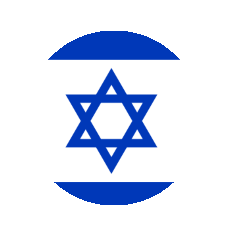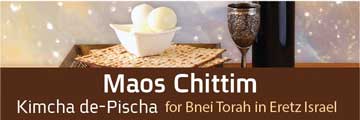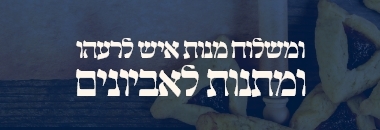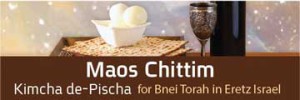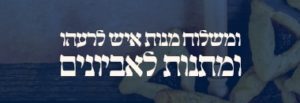The Torah obligates the shochet to give the foreleg, cheeks, and abomasum of every kosher four-legged animal to a kohen. Which cuts of meat are they? Are we permitted to purchase the relevant cuts in the supermarket, or does so involve theft of priestly gifts? Why is this mitzva not performed nowadays in commercial slaughtering? Is the gift obligatory also outside of Eretz Yisroel? What happens in Eretz Yisroel? What is done in commercial plants to circumvent the mitzva, and is it proper to do so? Of this and more, in the coming article.
Sources
In this week’s parasha we read: “And this shall be the kohanim’s due from the people, from those who slaughter, be it an ox or a sheep, he shall give the kohen the foreleg, the jaws, and the maw” (Devarim 18:3). The Mishna in Chullin, 10:1 writes: “The mitzvah of zeroa (foreleg), lechayayim (cheeks) and keiva (abomasum) is applicable in the land of Yisrael and outside the land of Yisrael, while the Temple stands and in its absence.” This halacha is echoed by the Rambam (Hilchos Bikkurim u’Matnos Kehuna 9:1), is the view of the Rishonim, and brought by the Shulchan Aruch (YD 61:21): “The giving of the foreleg, cheeks and abomasum is obligatory in all places – both in the land of Israel and outside of it, both when the Beis Hamikdash is present and when it is not.” Which cuts are included in this mitzva, and how is it applied nowadays?
In researching the current situation in Israel, I thankfully acknowledge the help I was afforded by two professional shochatim: Rabbi Netanel Gayat shlita from Rabbi Machpud’s kashrus agency, and Rabbi Moshe Retman shlita of She’eris Yisroel.
The first stage in understanding this mitzva is identifying the relevant cuts of meat and how they are called today. It is important to understand that when Chazal refer to body parts, their identification indicates to the relevant bone, including all the connected tissues (skin, meat, and tendons). When Chazal tell us a human has 248 limbs it means that he has 248 bones. The Mishna (Ohalos 1:8) lists them and how much meat around each bone is included.
The sketch below is the skeleton of a cow, which is similar to other kosher cattle:
The Foreleg
The foreleg is the upper front part of the animal’s right leg. This includes the two bones and all surrounding tissue from the shoulder blade down, excluding the hoof. In the above sketch, the shoulder bone is labeled #14, under which the foreleg begins. The foreleg includes the two bones labeled 15-16, and the lower bone labeled 17-18.
The surrounding tissue are cuts called beef shin, or shank. Despite their priestly status, not all shank bones or beef shin are part of this discussion: halacha mandates only the right foreleg given to the kohen while both right and left are equally distributed in the market and carry the same name.
Under the foreleg is a part of the hoof bones (# 19) which is used for making P’tcha or calf’s foot jelly. While this bone is not part of the gift, portions of the upper bone (#18), which is one of the gifted parts, is sold for the same purpose as well.
Defining which cuts of meat belong to the upper bone is debated among the poskim. The Taz (61:3) writes that it includes the entire width of the animal. Practically, it is unclear what is included in this definition. Apparently, it includes parts of the Minute Steak roasts and Petite Tender, as well as the Shin or Shank. Rabbi Yitzchak Zilberstein writes (Vavei Ha’amudim 18) that approximately one pound of the Petite Tender belongs to the kohen.
Standards and practices of butchery differ between countries. Variation with respect to the cuts and parts of the animal that are sold depend on the types of foods prepared by the customers. The above description refers to the butchering practices in Israel today. Rabbi Netanel Gait shlita told me that when they perform the mitzva of giving the priestly gifts they make it clear to the kohen that he probably is receiving some meat that doesn’t belong to him, and may have not received some of which does belong to him, both agreeing to forgive each other for the differences.
Summary: The main cut of the foreleg is the shin or shank bones, and the meat surrounding them. It certainly includes the Beef Banana Shank (which has recently made its appearance on the Israeli market), part of the Petite Tender, Minute Steak, as well as the bones used for calf’s foot jelly. Again, we must reiterate that this list only applies to the right foreleg and not the left one. When shopping from a butcher who cuts the meat in front of the customer it might be possible to know which side it comes from, but for meat sold in the freezer section of a supermarket, knowing which side of a steer it originated with is impossible.
The Cheek
What part of meat is included in the cheek? The cheek includes the tongue, which is one of the priciest cuts of meat, as well as the areas included in #2 in the sketch which are called Cheek Meat. In addition, it also includes the lower cheek (#3), a very fatty cut which is usually not sold.
The Pri Chadash (YD 61:4) and the Chochmas Adam (Sha’arei Tzedek, Mishpatei Ha’aretz 8:2) write that the cheek is only the lower cheek (Sifri 165; Rashi). The Pri Chadash explains that the cut is called cheeks in the plural because it includes both right and left sides. However the Gra understands the plural form is used to include both upper and lower cheeks. The Kanfei Yona and Da’as Torah (YD 61:3) wonder why we aren’t scrupulous to also give the lower cheek since Rabbi Yehonoson ben Uziel, a Tana, is of the opinion it is included in the gifts (see his targum to Devarim 18:3). Kanfei Yona concludes that despite the various opinions, practically, only the lower cheek is given, and Jewish custom determines the halacha.
The Abomasum
The abomasum is one of the four parts of the digestive system called the Tripe by butchers. The abomasum includes the fat that envelopes it and is generally not sold for meat, but rather used in cheese production for its rennet – an enzyme necessary for producing cheeses. Since today most dairies use synthetic rennet or other substitutes for cheese production, the abomasum doesn’t have much use today.
Giving the Priestly Gifts Nowadays
This mitzva is generally not performed today, and slaughterhouses, while certainly obligated to do so, don’t give the above identified cuts of meat to kohanim. There are people who long to perform this mitzva and buy a steer or lamb specifically for this purpose. Then, the mitzva is performed with great fanfare. In general, however, since the mitzva involves a significant financial loss, we are left with the question: is circumventing this mitzva acceptable? And can we, as consumers, buy and consume cuts of meat that rightfully belong to kohanim?
The question is multifaceted and involves several issues.
Location Considerations
The Gemara notes a discussion about where the mitzva applies. The majority of Rishonim rule it applies both in Eretz Yisroel and outside of it, while some limit it only to Eretz Yisroel. The Shulchan Aruch (YD 61:1), Chochmas Adam (Sha’arei Tzedek, Mishpatei Ha’aretz 8:1) follow the majority ruling, determining the mitzva applies outside of Eretz Yisroel as well as inside, noting however, that it is not practiced outside the Holy Land. The Gra (footnote 20) adds that one who does so will be blessed. The Pri Chadash (YD 61:32) notes that despite the accepted custom being not to give it, one who is scrupulous and does son is doing something proper and needs not to be concerned of coming across as haughty. The Plesi (61:6) wonders why we are not scrupulous in this mitzva and presumes perhaps it is due to the doubtful status of contemporary kohanim.
The Chasam Sofer (YD 301) describes how he always gave those cuts to a kohen’s wife whenever he slaughtered meat, and the Plesi (61:6) notes that his son in law, Rabbi Binyamin Wolf Frankel, would do the same. He adds that there are pious people who have a desire to perform the mitzva and give money to people going to Eretz Yisroel to purchase an animal and perform the mitzva on their behalf.
Slaughterhouses outside of Eretz Yisroel, customarily, never gave the priestly gifts, even if cattle was in full Jewish ownership due to the above-mentioned reasons.
Joint Jew-Gentile Ownership
The following halacha is an important addition: if both Jew and gentile own an animal together, including the cuts that belong to the kohen, there is no obligation to give those cuts. Let us explain:
A Jew and a gentile buy a calf together, signing an agreement that the forequarters belong to the Jew and the hindquarters – to the gentile. In this case, since the priestly gifts are in the forequarters, the cuts must be given to the kohen. However, if the entire calf is jointly owned, even if the gentile only owns 1% of the animal, or even only 1% of the priestly cuts, the mitzva is no longer applies and there is no obligation to give the gifts at all (YD 61:25).
Furthermore, the Rama adds (ibid) that if both Jew and gentile buy animals with the agreement that whatever turns out to be kosher goes to the Jew while those which are unkosher (for whatever reason) belong to the gentile (generally a ratio of 70% kosher to 30% unkosher), every animal, even if it turns out to be kosher, is no longer obligated in the priestly gifts. However, if, according to the contract, at the time of slaughtering all the cattle belong to a Jew, even if the unkosher ones will be purchased by a gentile after slaughtering, the animals are obligated in the priestly gifts (Pri Chadash, footnote 41).
Currently, in Israel, most cattle slaughterhouses are owned by non-Jews, including the cattle slaughtered in them. (The Saleh Dabbah and Sons Slaughterhouse in Dier El Assad in the Galilee is responsible for most of the meat slaughtered in Israel. The second largest slaughterhouse, Tenuva, is in Chinese ownership. Most of the smaller slaughterhouses are similarly owned by non-Jews.) Therefore, in general, even in Israel today, giving the priestly gifts is not applicable.
The question begins when slaughtering in a Jewish owned slaughterhouse or when a private dealer buys a specific number of cattle heads for his own butcher store, only paying the slaughterhouse for using their facilities. (This scenario is quite uncommon today, but it certainly was in the past). In these cases, the mitzva applies and the priestly gifts should be given to a kohen.
Nevertheless, even where a dealer buys the cattle ahead of time, in many cases the animals still have a gentile ownership because he must have a market for the hindquarters and the animals that turn out unkosher. Therefore, even in these cases, the mitzva is not applied.
Makirei Kehuna (“Recognizers Of Kehuna”)
One of the mehadrin kashrus agencies has an arrangement set up called a Makirei Kehuna (“recognizers of kehuna”) Contract. In the first few rounds of slaughtering the dealer gives the priestly gifts to one specific kohen. The kohen then becomes the recognized recipient of this dealer’s priestly gifts. From here on, all the dealer’s priestly gifts are considered his, even before they are actually given.
The Shulchan Aruch (YD 61:14) rules that where the Makir Kehuna – the designated kohen — is a poor talmid chacham, one can buy his gifts from him ahead of time since they are considered his even before actually receiving them. The above-mentioned kashrus agency gives their kohen a nice stipend every month, although it’s nowhere near even 1% of the value of the meat. In return, the kohen agrees to sell his gifts back to the dealer.
This halachic solution is not new. It was even mentioned in the Radvaz (volume I, chapter 340). There, he mentions that Mahari Kurkis opposed it with vengeance, claiming the priestly gifts are sold at much less than their value, involving a serious prohibition. However the Radvaz finds merit in it. The Achronim debate if it is permitted, and if done – if the sale is valid, or the gifts still need to be given.
Today there are many slaughterhouse owners and meat dealers who disregard this mitzva completely and don’t even have this kind of contract in place. The Israeli Chief Rabbinate has tried numerous times to convince slaughterhouses to use this agreement, with only partial cooperation.
Buying Meat
Here we come to the practical questions. Can a regular consumer go into his local supermarket and buy a tongue, for example, or does he have to be concerned it should have been given to a kohen and wasn’t?
The answer is that in most cases, this issue really doesn’t apply. Most cuts of meats sold in Israel are imported, and the custom is not to give the gifts outside Eretz Yisroel. In addition, most imported meat was in non-Jewish ownership at the time of slaughtering, with the agreement that if the animal turns out unkosher it remains in non-Jewish ownership.
For fresh meat in Eretz Yisroel, most of the market is controlled by non-Jewish slaughterhouses who own the animal at slaughtering. In addition, when buying the muscular parts of meat (shoulder roasts, shin, etc.,) the cuts may still originate in the left side of the animal, in which case the cut’s status is uncertain.
An additional halacha can be applied, even if the meat is known to have been slaughtered in a Jewish-owned slaughterhouse with no arrangement for giving the priestly gifts, and the cut is known to certainly be one (such as the tongue, or for a quarter of a lamb where it is easy to discern if it is the right or left side): priestly gifts can be stolen. Once the shochet or first owner stole the priestly gifts from the kohen and sold it to a retailer or butcher store, they no longer belong to kohanim, and can be consumed by anyone. Therefore, the consumer does not have a problem in any case.

